演讲教程1-the art of public speaking
The_art_of_public_speaking[1](1)
](https://img.taocdn.com/s3/m/0844a922ccbff121dd3683ed.png)
was first developed by the ancient Greeks. were taught first by a group of self-styled "sophists" who were known to "make the weaker argument the stronger." Plato and Aristotle developed theories of public speaking in opposition to the Sophists.
18
Public Speaking
a vital means of communication
a way of making your ideas public – of
sharing them with other people and of influencing other people
41% of the 3000 respondents listed "fear of public speaking" as their No.1 fear, while 19% listed "death."
The top 5 fears of people are : 1. Public speaking!!! 2. Heights. 3. Insects and bugs. 4. Financial problems. 5. Deep water.
• What applied skills and basic knowledge are most important for those you will hire with a four-year college diploma?
The Art of Public Speaking
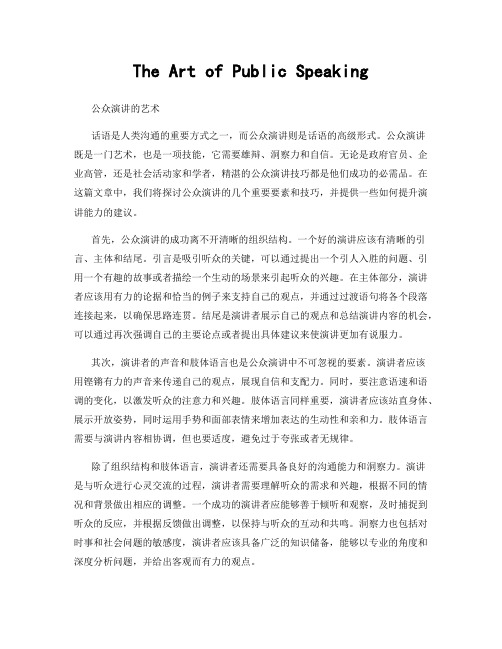
The Art of Public Speaking 公众演讲的艺术话语是人类沟通的重要方式之一,而公众演讲则是话语的高级形式。
公众演讲既是一门艺术,也是一项技能,它需要雄辩、洞察力和自信。
无论是政府官员、企业高管,还是社会活动家和学者,精湛的公众演讲技巧都是他们成功的必需品。
在这篇文章中,我们将探讨公众演讲的几个重要要素和技巧,并提供一些如何提升演讲能力的建议。
首先,公众演讲的成功离不开清晰的组织结构。
一个好的演讲应该有清晰的引言、主体和结尾。
引言是吸引听众的关键,可以通过提出一个引人入胜的问题、引用一个有趣的故事或者描绘一个生动的场景来引起听众的兴趣。
在主体部分,演讲者应该用有力的论据和恰当的例子来支持自己的观点,并通过过渡语句将各个段落连接起来,以确保思路连贯。
结尾是演讲者展示自己的观点和总结演讲内容的机会,可以通过再次强调自己的主要论点或者提出具体建议来使演讲更加有说服力。
其次,演讲者的声音和肢体语言也是公众演讲中不可忽视的要素。
演讲者应该用铿锵有力的声音来传递自己的观点,展现自信和支配力。
同时,要注意语速和语调的变化,以激发听众的注意力和兴趣。
肢体语言同样重要,演讲者应该站直身体、展示开放姿势,同时运用手势和面部表情来增加表达的生动性和亲和力。
肢体语言需要与演讲内容相协调,但也要适度,避免过于夸张或者无规律。
除了组织结构和肢体语言,演讲者还需要具备良好的沟通能力和洞察力。
演讲是与听众进行心灵交流的过程,演讲者需要理解听众的需求和兴趣,根据不同的情况和背景做出相应的调整。
一个成功的演讲者应能够善于倾听和观察,及时捕捉到听众的反应,并根据反馈做出调整,以保持与听众的互动和共鸣。
洞察力也包括对时事和社会问题的敏感度,演讲者应该具备广泛的知识储备,能够以专业的角度和深度分析问题,并给出客观而有力的观点。
提升公众演讲能力需要时间和实践。
首先,演讲者可以通过加入演讲俱乐部或者参加演讲比赛来提高自己的技巧。
以发表公开演讲为主题英语作文

以发表公开演讲为主题英语作文{z}Title: The Art of Public SpeakingPublic speaking is an essential skill that is valuable in both personal and professional life.It is the ability to convey thoughts, ideas, and information to an audience in an effective, clear, and engaging manner.Whether it is addressing a small group of colleagues or a large crowd at a conference, public speaking offers an opportunity to share insights, inspire others, and leave a lasting impact.To deliver an effective public speech, several key elements should be considered.Firstly, understanding the audience is crucial.Knowing their background, interests, and expectations helps tailor the speech to resonate with them.Secondly, having a clear purpose and structure for the speech is important.This includes introducing the topic, providing main points, supporting evidence, and a conclusion.第三ly, using appropriate language, tone, and delivery can enhance the speech"s ing clear and concise language, varying tone to convey emotions, and maintaining good body language are important aspects of public speaking.Furthermore, effective public speaking involves overcoming nerves and自信.Practice, whether through simulated speeches or actual speaking engagements, helps build confidence and ease nervousness.Additionally, being adaptable and prepared for unexpectedsituations is crucial.Public speakers should be ready to handle questions, interruptions, or technical issues with grace and composure.Public speaking offers numerous benefits, including improved communication skills, increased confidence, and enhanced leadership abilities.It is a powerful tool that can be used to inspire, inform, and influence others.With practice and dedication, anyone can master the art of public speaking and reap its rewards.In conclusion, public speaking is a valuable skill that plays a significant role in personal and professional growth.By understanding the audience, having a clear structure, using effective language, and practicing confidence-building techniques, one can deliver impactful speeches that leave a lasting impression.Embrace the challenge and opportunity of public speaking, and watch as it transforms your life and the lives of those you inspire.。
英语演讲的艺术
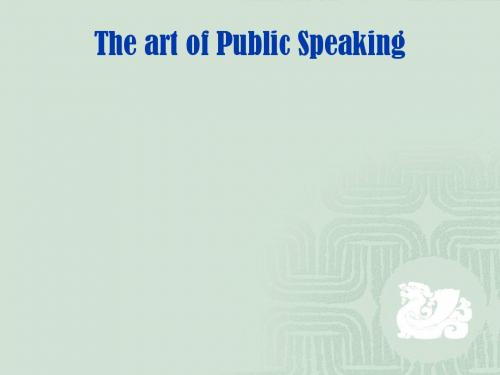
The art of Public speaking
首先从“外研社杯”全国 英语大赛比赛规则讲起
The art of Public speaking
Speaking
The art of Public Speaking
比赛程序
第一阶段 1. 定题演讲:每位选手演讲时间3分钟 题目:What we cannot afford to lose
The art of Public Speaking
评分标准
第一阶段:
prepared 20% 20%
20%
questions 15% 15%
10%
total
100
content language
delivery
The art of Public Speaking
第二阶段:
即兴演讲 回答问题 综合知识 合计
theartofpublicspeakingtheartofpublicspeaking首先从外研社杯全国首先从外研社杯英语大赛比赛规则讲起全国theartofpublicspeakingspeakingtheartofpublicspeaking?比赛程序?第一阶段?1
The art of Public Speaking
The art of Public Speaking
Japanese businessmen have already applied Confucian ethics in the their business management, and the American military academy, West Point, has taken Sunzi’s The Art of War as one of their textbooks. In theses years, the cream of our culture, such as traditional medical science and medicine, acupuncture, Tai Chi, and paper cutting, has won popularity in the world.
theartofpublicspeaking公共演讲的艺术

9 The art of public Speaking 公共演讲的艺术1. The need for effective public speaking will almost certainly touch you sometime in your life. When it does, you want to be ready. But even if you never give another speech i n your life, you still have much to gain from studying public speaking. Your speech class will give you training in researching topics, organizing your ideas, and presenting yourself skillfully. The training is invaluable for every type of communication.1、在你生活的某个时刻,几乎必定(almost certainly)需要做某种有影响力的(effective)公开演讲。
当这个时刻来到时,你希望自己十分有把握。
但是,即便你在生活中从未发表过一个演讲,你仍然会从学习公共演说中获益良多(gain from)。
你的演讲课将会在研究主题、组织思路和表现技巧方面对你进行训练。
这种训练对任何类型的交流都是非常宝贵的(invaluable)。
2. There are many similarities between public speaking and daily conversation. The three major goals of speaking-to inform, to persuade, to entertain-are also the three major goals of everyday conversation. In conversation, almost without thinking about it, you employ a wide range of skills. You organize your ideas logically. You tailor your message to your audience. You tell a story for maximum impact. You adapt to feedback from your listener. These are among the most important skills you will need for public speaking.2、在公开演讲(public speaking)和日常交谈(daily conversation)之间有许多类似的东西(similarity)。
公开发表演讲英语作文
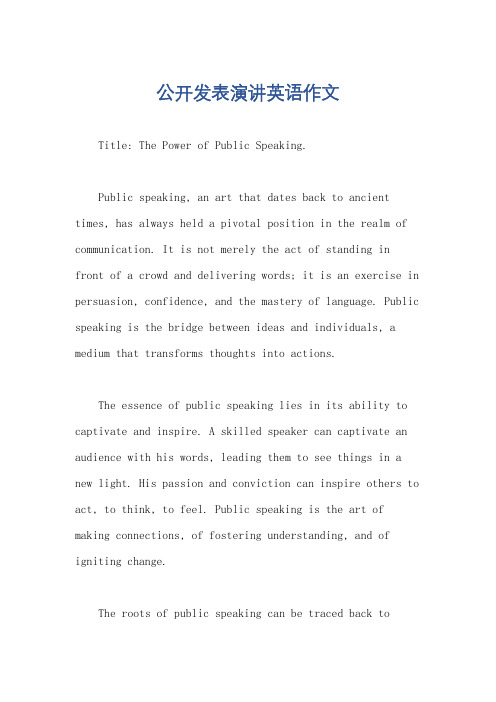
公开发表演讲英语作文Title: The Power of Public Speaking.Public speaking, an art that dates back to ancient times, has always held a pivotal position in the realm of communication. It is not merely the act of standing infront of a crowd and delivering words; it is an exercise in persuasion, confidence, and the mastery of language. Public speaking is the bridge between ideas and individuals, a medium that transforms thoughts into actions.The essence of public speaking lies in its ability to captivate and inspire. A skilled speaker can captivate an audience with his words, leading them to see things in a new light. His passion and conviction can inspire others to act, to think, to feel. Public speaking is the art of making connections, of fostering understanding, and of igniting change.The roots of public speaking can be traced back toancient Greece, where philosophers and statesmen would gather to debate and persuade. These early speakers were not just orators, but also teachers and leaders. They used their words to shape the course of history, to influence the thoughts and actions of their listeners.In modern times, public speaking has evolved, becoming more accessible and inclusive. It is no longer confined to the elite or the privileged; it has become a tool that can be wielded by anyone with a message to convey. This democratization of public speaking has led to a morevibrant and diverse discourse, where diverse voices can be heard and different perspectives can be shared.However, the art of public speaking is not easily mastered. It requires dedication, practice, and perseverance. A speaker must cultivate the ability to speak clearly and confidently, to engage his audience, and to convey his message effectively. He must also be able to adapt to different audiences and situations, to read their needs and emotions, and to tailor his speech accordingly.The benefits of public speaking are numerous. It can help individuals build confidence, develop criticalthinking skills, and enhance their communication abilities. It can also be a powerful tool for social change, for bringing about awareness and action on important issues. Public speaking has the potential to unite people, to inspire them to act, and to create a more inclusive and understanding society.In conclusion, public speaking is much more than just speaking in public. It is an art that requires skill, dedication, and practice. It is a medium for ideas, a bridge between individuals, and a tool for social change. As we move forward in an increasingly interconnected world, the importance of public speaking cannot be overstated. It is a skill that can open doors, inspire action, and shape the future. Let us embrace the power of public speaking and use it to create a more understanding, inclusive, and inspired world.。
当众演讲的英文作文
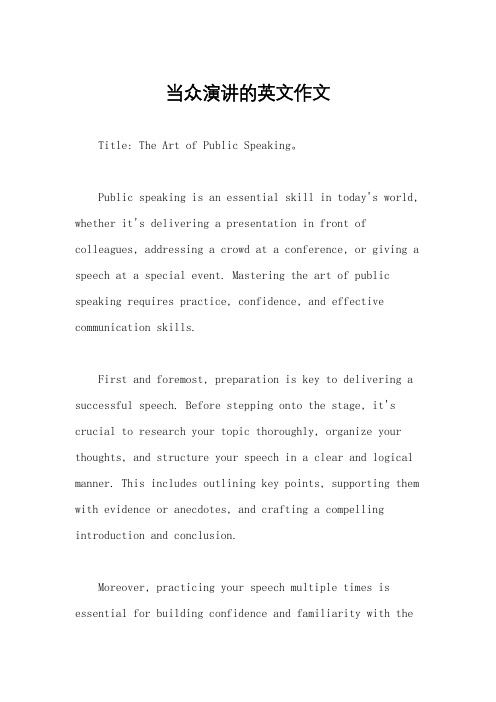
当众演讲的英文作文Title: The Art of Public Speaking。
Public speaking is an essential skill in today's world, whether it's delivering a presentation in front of colleagues, addressing a crowd at a conference, or giving a speech at a special event. Mastering the art of public speaking requires practice, confidence, and effective communication skills.First and foremost, preparation is key to delivering a successful speech. Before stepping onto the stage, it's crucial to research your topic thoroughly, organize your thoughts, and structure your speech in a clear and logical manner. This includes outlining key points, supporting them with evidence or anecdotes, and crafting a compelling introduction and conclusion.Moreover, practicing your speech multiple times is essential for building confidence and familiarity with thematerial. Rehearsing in front of a mirror, recording yourself, or giving the speech to a trusted friend orfamily member can help refine your delivery and identify areas for improvement.Body language plays a significant role in public speaking. Maintaining good posture, making eye contact with the audience, and using gestures to emphasize key pointscan enhance your credibility and engage listeners. Additionally, being mindful of your tone of voice, pace,and volume can help convey your message effectively andkeep the audience attentive.Furthermore, connecting with your audience on apersonal level can make your speech more impactful. Sharing personal stories, asking rhetorical questions, or incorporating humor can help establish rapport and keep listeners engaged throughout your presentation.Handling nerves is a common challenge for many speakers. While it's natural to feel anxious before speaking in public, there are strategies to manage nerves and boostconfidence. Techniques such as deep breathing, positive visualization, and focusing on the message rather than the audience's reaction can help calm your nerves and maintain composure on stage.In addition to verbal communication, visual aids can enhance the effectiveness of your speech. PowerPoint slides, props, or multimedia presentations can help reinforce key points, provide visual interest, and facilitate understanding for the audience. However, it's important to use visual aids sparingly and ensure they complement rather than distract from your message.Moreover, being prepared to handle unexpectedsituations or questions from the audience is crucial for maintaining control and credibility as a speaker. Anticipating potential challenges, practicing impromptu speaking, and remaining flexible can help you navigate unforeseen circumstances with confidence and poise.In conclusion, public speaking is a valuable skill that can empower individuals to communicate effectively, inspireothers, and influence positive change. By mastering the art of public speaking through preparation, practice, and effective communication techniques, anyone can become a confident and compelling speaker capable of captivating audiences and making a lasting impact.。
大学演讲英语教材
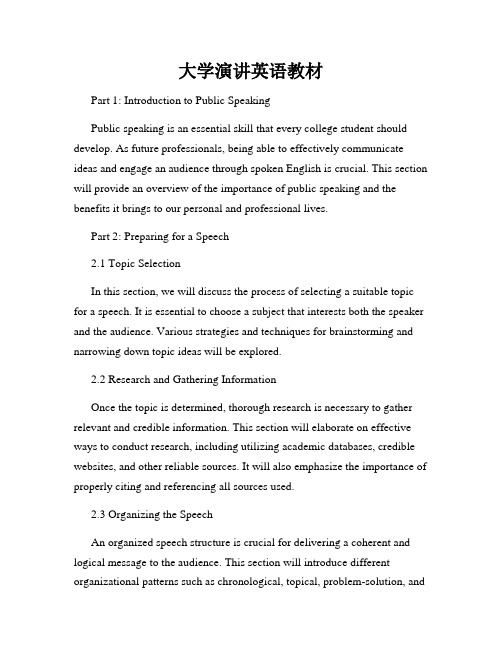
大学演讲英语教材Part 1: Introduction to Public SpeakingPublic speaking is an essential skill that every college student should develop. As future professionals, being able to effectively communicate ideas and engage an audience through spoken English is crucial. This section will provide an overview of the importance of public speaking and the benefits it brings to our personal and professional lives.Part 2: Preparing for a Speech2.1 Topic SelectionIn this section, we will discuss the process of selecting a suitable topic for a speech. It is essential to choose a subject that interests both the speaker and the audience. Various strategies and techniques for brainstorming and narrowing down topic ideas will be explored.2.2 Research and Gathering InformationOnce the topic is determined, thorough research is necessary to gather relevant and credible information. This section will elaborate on effective ways to conduct research, including utilizing academic databases, credible websites, and other reliable sources. It will also emphasize the importance of properly citing and referencing all sources used.2.3 Organizing the SpeechAn organized speech structure is crucial for delivering a coherent and logical message to the audience. This section will introduce different organizational patterns such as chronological, topical, problem-solution, andcause-effect. Additionally, it will provide tips on creating an engaging introduction, clear main points, and a memorable conclusion.Part 3: Enhancing Delivery Skills3.1 Body Language and GesturesNon-verbal communication plays a significant role in public speaking. This section will discuss the importance of body language, including posture, facial expressions, and hand gestures. It will provide suggestions on how to effectively use these non-verbal cues to enhance the delivery and overall impact of a speech.3.2 Voice Projection and ArticulationSpeaking clearly and audibly is essential for capturing the audience's attention and ensuring comprehension. Techniques for improving voice projection and articulation will be explored, including vocal warm-ups, breath control exercises, and pronunciation practice.3.3 Visual Aids and Presentation ToolsVisual aids and technology can greatly enhance a presentation. This section will cover the effective use of PowerPoint slides, charts, graphs, and other presentation tools. Moreover, it will emphasize the importance of using visuals sparingly and ensuring they enhance, rather than distract from, the speaker's message.Part 4: Engaging the Audience4.1 Establishing RapportBuilding a connection with the audience is key to engaging and maintaining their interest throughout the speech. This section will provide strategies for establishing rapport, such as making eye contact, using humor appropriately, and storytelling.4.2 Effective Use of LanguageSpeeches should be delivered in a language that is accessible to the audience. This section will discuss the importance of using clear and concise language, avoiding jargon or excessive technical terms, and incorporating rhetorical devices to enhance the audience's understanding and engagement.4.3 Handling Q&A SessionsThe ability to handle questions effectively is an essential skill for any public speaker. This section will provide tips on how to anticipate potential questions, listen attentively, and respond confidently and succinctly. It will also emphasize the value of acknowledging and appreciating audience participation.Part 5: Overcoming Fear and Building Confidence5.1 Managing AnxietyPublic speaking can be a source of anxiety for many individuals. This section will address common fears associated with public speaking and provide practical strategies for managing anxiety, including deep breathing exercises, visualization techniques, and positive self-talk.5.2 Rehearsal and PracticeRehearsing and practicing a speech is crucial for building confidence. This section will discuss the importance of practicing delivery, timing, and gestures. It will also provide guidance on seeking feedback from peers or mentors to further improve the overall presentation.5.3 Inspiring ConfidenceConfidence is a key ingredient in delivering a successful speech. This section will offer suggestions on how to boost self-confidence, such as adopting a positive mindset, visualizing success, and celebrating small achievements along the way.Conclusion:Mastering the art of public speaking is a lifelong journey. This comprehensive and practical guide aims to equip college students with the necessary skills and knowledge to excel in public speaking. By embracing the principles discussed in this textbook, students will become confident and persuasive speakers, ready to make a positive impact in their future endeavors.。
在公众面前演讲的作文英语

Public speaking is an art that requires a combination of confidence, preparation, and the ability to engage an audience. Heres an essay on the topic:The Art of Public SpeakingPublic speaking is a skill that can be both daunting and rewarding. It is the act of addressing an audience in a formal setting, conveying a message, sharing knowledge, or expressing an opinion. Mastering this art form can lead to personal growth, professional success, and the ability to influence others.The Importance of ConfidenceConfidence is the cornerstone of effective public speaking. A speaker who is selfassured can command the attention of the audience and deliver their message with clarity and conviction. Building confidence often starts with selfreflection and understanding ones strengths. It is also crucial to practice the speech thoroughly to ensure familiarity with the content, which can alleviate anxiety.Preparation: The Key to SuccessPreparation is the bedrock of any successful public speaking engagement. This involves researching the topic extensively, organizing thoughts logically, and structuring the speech to have a clear introduction, body, and conclusion. Knowing the audience is equally important, as it helps tailor the speech to their interests and expectations.Engaging the AudienceAn engaging speaker is one who can connect with the audience on an emotional level. This can be achieved through storytelling, using relatable examples, and employing rhetorical devices such as analogies and metaphors. Moreover, maintaining eye contact, using appropriate body language, and varying the tone and pace of speech can make the delivery more dynamic and captivating.Overcoming NervousnessIt is natural to feel nervous before a public speaking engagement. However, there are strategies to manage this anxiety. Deep breathing exercises, visualization techniques, and positive affirmations can help calm the nerves. Additionally, viewing the audience assupportive rather than judgmental can shift the mindset and reduce stress.Adapting to the MomentA skilled public speaker is also adept at adapting to unexpected situations. This could involve dealing with technical difficulties, handling questions from the audience, or adjusting the speech based on the rooms atmosphere. Flexibility and quick thinking are essential in such scenarios.The Power of PracticePractice makes perfect in the realm of public speaking. Rehearsing the speech multiple times, ideally in front of a mirror or with a test audience, can help refine the delivery. It also provides an opportunity to receive feedback and make necessary adjustments.ConclusionIn conclusion, public speaking is a powerful tool for communication and persuasion. It requires a blend of confidence, thorough preparation, audience engagement, and the ability to adapt. By honing these skills, one can become a more effective communicator and leave a lasting impression on any audience.This essay provides a comprehensive overview of the elements that contribute to successful public speaking, offering insights into how to prepare, engage, and overcome common challenges associated with speaking in public.。
The Art of Public Speaking
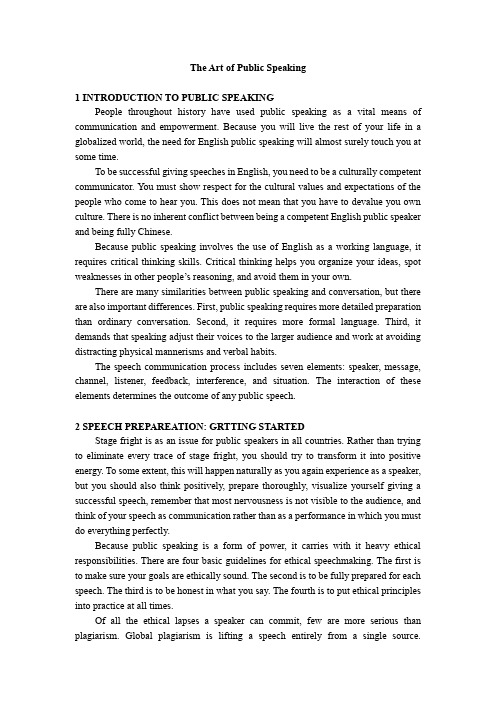
The Art of Public Speaking1 INTRODUCTION TO PUBLIC SPEAKINGPeople throughout history have used public speaking as a vital means of communication and empowerment. Because you will live the rest of your life in a globalized world, the need for English public speaking will almost surely touch you at some time.To be successful giving speeches in English, you need to be a culturally competent communicator. You must show respect for the cultural values and expectations of the people who come to hear you. This does not mean that you have to devalue you own culture. There is no inherent conflict between being a competent English public speaker and being fully Chinese.Because public speaking involves the use of English as a working language, it requires critical thinking skills. Critical thinking helps you organize your ideas, spot weaknesses in other people’s reasoning, and av oid them in your own.There are many similarities between public speaking and conversation, but there are also important differences. First, public speaking requires more detailed preparation than ordinary conversation. Second, it requires more formal language. Third, it demands that speaking adjust their voices to the larger audience and work at avoiding distracting physical mannerisms and verbal habits.The speech communication process includes seven elements: speaker, message, channel, listener, feedback, interference, and situation. The interaction of these elements determines the outcome of any public speech.2 SPEECH PREPAREATION: GRTTING STARTEDStage fright is as an issue for public speakers in all countries. Rather than trying to eliminate every trace of stage fright, you should try to transform it into positive energy. To some extent, this will happen naturally as you again experience as a speaker, but you should also think positively, prepare thoroughly, visualize yourself giving a successful speech, remember that most nervousness is not visible to the audience, and think of your speech as communication rather than as a performance in which you must do everything perfectly.Because public speaking is a form of power, it carries with it heavy ethical responsibilities. There are four basic guidelines for ethical speechmaking. The first is to make sure your goals are ethically sound. The second is to be fully prepared for each speech. The third is to be honest in what you say. The fourth is to put ethical principles into practice at all times.Of all the ethical lapses a speaker can commit, few are more serious than plagiarism. Global plagiarism is lifting a speech entirely from a single source.Patchwork plagiarism involves cutting and pasting a speech from a limited number of sources. Incremental plagiarism occurs when a speaker fails to give credit for specific quotations and paraphrases that are borrowed from other people.Because it is so easy to copy information from the Internet, it poses special challenges with regard to plagiarism. If you don’t cite Internet sources, you are just as guilty of plagiarism as if you take information from print sources without proper citation. As you research your speeches, be sure to take accurate notes of the Internet sources you use so you can identify them in you speech.3 SPEECH PREPARATION: ORGANIZING AND OUTLININGOne of your first assignments will be to present an introductory speech, either a speech of self-introduction or a speech introducing a classmate. Focus the speech on a limited number of ideas and be creative in developing them. Use interesting supporting materials and present them in colorful, descriptive language.When organizing the speech, make sure you have a clear introduction, body, and conclusion. Most introductory speeches fall naturally into chronological or topical order. Using clear transitions will help your audience follow you from point to point.Although you will write a complete manuscript or outline of your speech when preparing it, you should deliver it extemporaneously. This means you have rehearsed fully and can present you talk from a brief set of speaking notes. Concentrate on establishing eye contact with the audience and on speaking in a dynamic, engaged tone of voice.4 PRESENTING THE SPEECHThe first step in speechmaking is choosing a topic. If you have trouble picking a topic, you can use clustering, a personal inventory, or an Internet search to come up with something that is right for you.The general purpose of your speech will usually be to inform or to persuade. When your general purpose is to inform, your goal is to persuade, your goal is to communicate information clearly, accurately, and interesting. When your general purpose is to persuade, your goal is to win listeners over to your point of view.Once you know your topic and general purpose, you must focus on a specific purpose statement that indicates precisely what your speech seeks to achieve. The specific purpose statement should (1) be a full infinitive phrase; (2) be worded as a statement, not a question; (3) avoid figurative language; (4) not be vague or general; (5) be appropriate for your audience; and (6) be achievable in the allotted time.The central idea is a concise statement of what you will say in your speech, and it usually crystallizes in your thinking after you have done your research and have decided on the main point. In most cases, it encapsulates the main points in a single declarativesentence.5 V ARIETIES OF PUBLIC SPEACKINGGood speakers are audience-centered. When working on your speeches, keep three questions in mind: To whom am I speaking? What do I want them to know, believe, or do as result of my speech? What is the most effective way of composing and presenting my speech to accomplish that aim?People are egocentric. They typically approach speeches with one question uppermost in mind: “Why is this important to me?” Therefore, you need to study your audience and adapt your speech to their beliefs and interests.The major factors to consider in audience analysis are size, physical setting, demographic traits, disposition toward the topic, disposition toward the speaker, and disposition toward the occasion. For speeches outside the classroom, you can get information about the audience by asking the person who invites you to speak. For classroom speeches, you can circulate an audience-analysis questionnaire.Once you complete the audience analysis, you must adapt your speech so it will be clear and convincing. Try to hear the speech as your listeners will. Anticipate questions and objections, and try to answer them in advance. When you deliver the speech, keep an eye out for audience feedback, and adjust your remarks in response. After the speech, think about your audience’s res ponse and about changes you would make if you were delivering the speech again.References:[1] Stephen, E, Lucas. The Art of Public Speaking[M]. Beijing: Foreign Language Teaching and Researching Press, 2010.If you have any questions please contact me at davidtsing@©David Tsing2018-4-21 at Beijing。
The-art-of-public-speaking-chapter-1-.2-.3PPT优秀课件

10%
• Lecture Report
20%
• Class Activity Participation 20%
• Speech Writing
20%
• Speech Presentation
30%
McGraw-Hill
© 2007 Stephen E. Lucas. All rights reserved.
Chinese heritage
English Language
To respect diversity of culture√ Avoid ethnocentrism√
McGraw-Hill
© 2007 Stephen E. Lucas. All rights reserved.
Slide 8
Cultural Diversity and Public Speaking
•Even meanings attached to gestures for such basic messages as “yes” and “no” are culturally based.
McGraw-Hill
© 2007 Stephen E. Lucas. All rights reserved.
•Speechmaking becomes more complex as cultural diversity increases.
•Not only do words change from language to language, but so do ways of thinking and of seeing the world.
public speaking
job hunting
英语演讲稿-公众演说的魅力
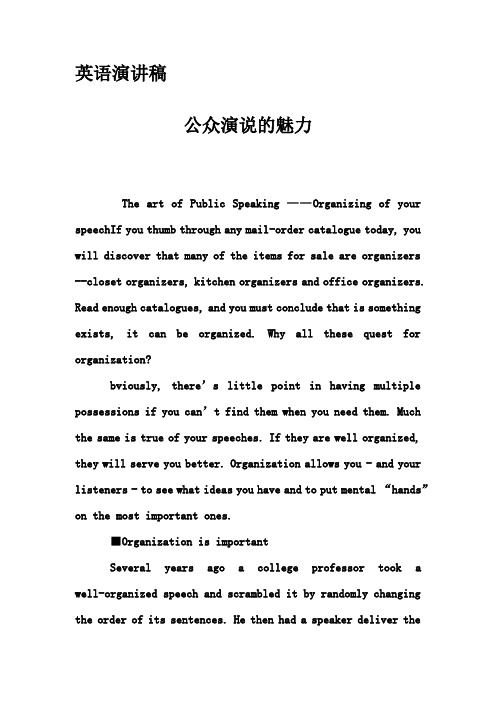
英语演讲稿公众演说的魅力The art of Public Speaking ——Organizing of your speechIf you thumb through any mail-order catalogue today, you will discover that many of the items for sale are organizers --closet organizers, kitchen organizers and office organizers. Read enough catalogues, and you must conclude that is something exists, it can be organized. Why all these quest for organization?bviously, there’s little point in having multiple possessions if you can’t find them when you need them. Much the same is true of your speeches. If they are well organized, they will serve you better. Organization allows you - and your listeners - to see what ideas you have and to put mental “hands”on the most important ones.■Organization is importantSeveral years ago a college professor took a well-organized speech and scrambled it by randomly changing the order of its sentences. He then had a speaker deliver theoriginal version to one group of listeners and the scrambled version to another group. After the speeches, he gave a test to see how well each group understood what they had heard. Not surprisingly, the group that heard the original, unscrambled speech scored much higher than the other group.A few years later, two professors repeated the same experiment at another school. But instead of testing how well the listeners comprehended each speech, they tested to see what effects the speeches had on the listeners?attitudes toward the speakers. They found that people who heard the well-organized speech believed the speaker to be much more competent and trustworthy than did those who heard the scrambled speech.These are just two of many studies that show the importance of organization in speechmaking. You realize how difficult it is to pay attention to the speaker, much less to understand the message. In fact, when students explain what they hope to learn from their speech class, they almost always put “the ability to organize my ideas more effectively”near the top of the list. This ability is especially vital for speechmaking. Listeners have little patience with speakers who bounce wildly from idea to idea. Keep in mind that listeners cannot flip back to a previous page if they have troublegrasping a speaker’s ideas. In this respect a speech is much like a movie. A speaker must be sure listeners can follow the progression of ideas from beginning to end. This requires that speeches be organized strategically.The first step in developing a strong sense of speech organization is to gain command of the three basic parts of a speech - introduction, body, and conclusion - and the strategic role of each. The body is the longest and most important part. Also, you will usually prepare the body first. It is much easier to create an effective introduction after you know exactly what you will say in the body. The process of organizing the body of a speech begins when you determine the main points.■Main pointsThe main points are the central features of your speech. You should select them carefully, phrase them precisely, and arrange them strategically. Here are the main points of a student speech about the medical uses of hypnosis: Specific purpose:To inform my audience about the major uses of hypnosis.Central Idea:The major uses of hypnosis today are to control pain inmedical surgery, to help people stop smoking, and to help students improve their academic performance.Main points:1. Hypnosis is used in surgery as an adjunct to chemical anesthesia.2. Hypnosis is used to help people stop smoking.3. Hypnosis is used to help students improve their academic performance.These three main points form the skeleton of the body of the speech. If there are three major uses of hypnosis for medical purposes, then logically there can be three main points in the speech.Sometimes main points are evident from your specific purpose statement. Even if they are not stated expressly, they may be easy to project from statement. Often they will emerge as you research the speech and evaluate your findings. Suppose your specific purpose is “To persuade my audience that our state should not approve proposals for online voting.” You know that each main point in the speech will present a reason why online voting should not be instituted in your state. But you aren’t sure how many main points there will be or what they will be. As you research and study the topic, you decidethere are two major reasons to support your view. Each of these reasons will become a main point in your speech.Number of main pointsYou will not have time in your classroom speeches to develop more than four or five main points, and most speeches will contain only two or three. Regardless of how long a speech might run, if you have too many main points, the audience will have trouble sorting them out. When everything is equally important, nothing is important. If when you list your main points, you find you have too many, you may be able to condense them into categories.Strategic order of Main PointsOnce you establish your main points, you need to decide in what order you will present them in your speech. This is extremely important, for it will affect both the clarity and the persuasiveness of you idea. The most effective order depends on three things - your topic, your purpose, and your audience. Five basic patterns of organization used most often by public speaker: chronological, spatial, causal, problem-solution, and topical order.Tips for preparing main pointsEach main point in a speech should be clearly independentof the other main points. Take care not to lump together what should be separate main points. And because main points are so important, you want to be sure they all receive enough emphasis to be clear and convincing. This means allowing sufficient time to develop each main point. This is not to say that all main points must receive exactly equal emphasis, but only that they should be roughly balance.■SummaryClear organization is vital to speechmaking. Listeners demand coherence. They get only one chance to grasp a speaker’s ideas, and they have little patience for speakers who ramble aimlessly from one idea to another. A well-organized speech will enhance your credibility and make it easier for the audience to understand your message. Speeches should be organized strategically. They should be put together in particular ways to achieve particular results with particular audiences.The process of planning the body of a speech begins when you determine the main points. These are the central features of your speech. You should choose them carefully, phrase them precisely, and organize them strategically. Because listeners cannot keep track of a multitude of main points, most speechesshould contain no more than two to five main points. Each main point should focus on a single idea, should be worded clearly, and should receive enough emphasis to be clear and convincing. Supporting materials are the backup ideas for your main points. When organizing supporting materials, make sure they are directly relevant to the main points they are supposed to support. And connectives help tie a speech together. They are words or phrases that join one thought to another and indicate the relationship between them. Using them effectively will make your speeches more unified and coherent.。
演讲的艺术(第十三版)(中国版)教师用书Chapter_1_Speaking_in_Public
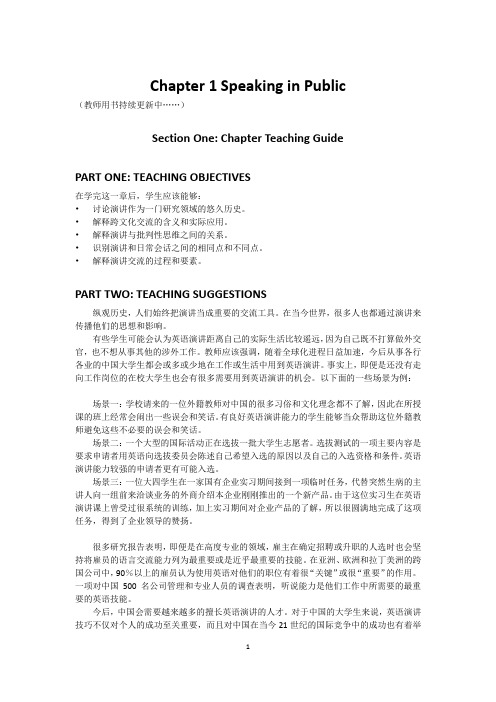
Chapter 1 Speaking in Public(教师用书持续更新中……)Section One: Chapter Teaching GuidePART ONE: TEACHING OBJECTIVES在学完这一章后,学生应该能够:•讨论演讲作为一门研究领域的悠久历史。
•解释跨文化交流的含义和实际应用。
•解释演讲与批判性思维之间的关系。
•识别演讲和日常会话之间的相同点和不同点。
•解释演讲交流的过程和要素。
PART TWO: TEACHING SUGGESTIONS纵观历史,人们始终把演讲当成重要的交流工具。
在当今世界,很多人也都通过演讲来传播他们的思想和影响。
有些学生可能会认为英语演讲距离自己的实际生活比较遥远,因为自己既不打算做外交官,也不想从事其他的涉外工作。
教师应该强调,随着全球化进程日益加速,今后从事各行各业的中国大学生都会或多或少地在工作或生活中用到英语演讲。
事实上,即便是还没有走向工作岗位的在校大学生也会有很多需要用到英语演讲的机会。
以下面的一些场景为例:场景一:学校请来的一位外籍教师对中国的很多习俗和文化理念都不了解,因此在所授课的班上经常会闹出一些误会和笑话。
有良好英语演讲能力的学生能够当众帮助这位外籍教师避免这些不必要的误会和笑话。
场景二:一个大型的国际活动正在选拔一批大学生志愿者。
选拔测试的一项主要内容是要求申请者用英语向选拔委员会陈述自己希望入选的原因以及自己的入选资格和条件。
英语演讲能力较强的申请者更有可能入选。
场景三:一位大四学生在一家国有企业实习期间接到一项临时任务,代替突然生病的主讲人向一组前来洽谈业务的外商介绍本企业刚刚推出的一个新产品。
由于这位实习生在英语演讲课上曾受过很系统的训练,加上实习期间对企业产品的了解,所以很圆满地完成了这项任务,得到了企业领导的赞扬。
很多研究报告表明,即便是在高度专业的领域,雇主在确定招聘或升职的人选时也会坚持将雇员的语言交流能力列为最重要或是近乎最重要的技能。
The Art of Public Speaking Captivating Audiences
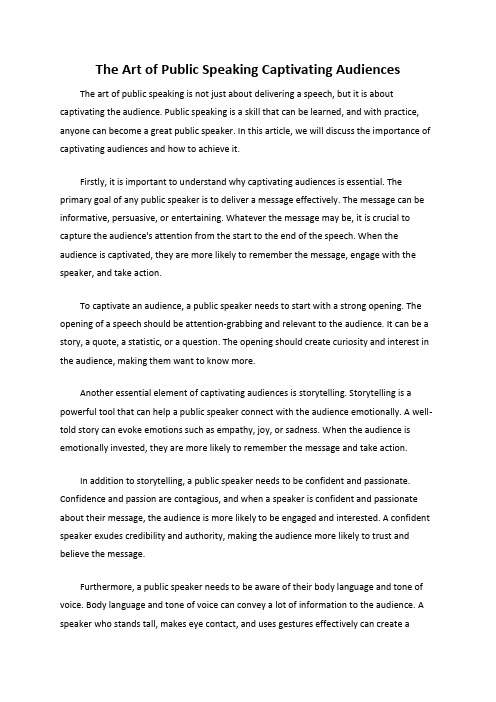
The Art of Public Speaking Captivating Audiences The art of public speaking is not just about delivering a speech, but it is about captivating the audience. Public speaking is a skill that can be learned, and with practice, anyone can become a great public speaker. In this article, we will discuss the importance of captivating audiences and how to achieve it.Firstly, it is important to understand why captivating audiences is essential. The primary goal of any public speaker is to deliver a message effectively. The message can be informative, persuasive, or entertaining. Whatever the message may be, it is crucial to capture the audience's attention from the start to the end of the speech. When the audience is captivated, they are more likely to remember the message, engage with the speaker, and take action.To captivate an audience, a public speaker needs to start with a strong opening. The opening of a speech should be attention-grabbing and relevant to the audience. It can be a story, a quote, a statistic, or a question. The opening should create curiosity and interest in the audience, making them want to know more.Another essential element of captivating audiences is storytelling. Storytelling is a powerful tool that can help a public speaker connect with the audience emotionally. A well-told story can evoke emotions such as empathy, joy, or sadness. When the audience is emotionally invested, they are more likely to remember the message and take action.In addition to storytelling, a public speaker needs to be confident and passionate. Confidence and passion are contagious, and when a speaker is confident and passionate about their message, the audience is more likely to be engaged and interested. A confident speaker exudes credibility and authority, making the audience more likely to trust and believe the message.Furthermore, a public speaker needs to be aware of their body language and tone of voice. Body language and tone of voice can convey a lot of information to the audience. A speaker who stands tall, makes eye contact, and uses gestures effectively can create apositive impression on the audience. Similarly, a speaker who uses a clear and expressive tone of voice can make the message more engaging and memorable.Lastly, a public speaker needs to be aware of the audience's needs and expectations. The audience's needs and expectations can vary depending on the context of the speech. For example, a speech delivered to a group of professionals may require a more formal tone, whereas a speech delivered to a group of teenagers may require a more casual tone. Understanding the audience's needs and expectations can help a speaker tailor their message to the audience, making it more relevant and engaging.In conclusion, the art of public speaking is not just about delivering a speech, but it is about captivating the audience. Captivating an audience requires a strong opening, storytelling, confidence and passion, effective body language and tone of voice, and an understanding of the audience's needs and expectations. With practice and dedication, anyone can become a great public speaker and captivate their audience.。
当众发表的演讲英语作文
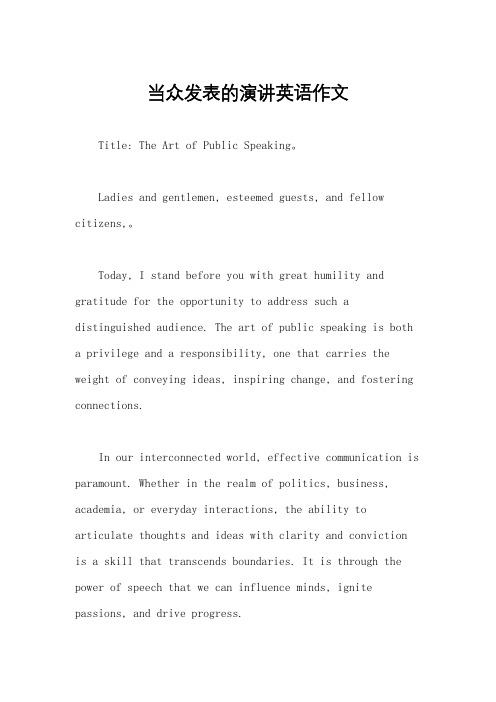
当众发表的演讲英语作文Title: The Art of Public Speaking。
Ladies and gentlemen, esteemed guests, and fellow citizens,。
Today, I stand before you with great humility and gratitude for the opportunity to address such a distinguished audience. The art of public speaking is both a privilege and a responsibility, one that carries the weight of conveying ideas, inspiring change, and fostering connections.In our interconnected world, effective communication is paramount. Whether in the realm of politics, business, academia, or everyday interactions, the ability to articulate thoughts and ideas with clarity and conviction is a skill that transcends boundaries. It is through the power of speech that we can influence minds, ignite passions, and drive progress.First and foremost, a successful speech begins with thorough preparation. Researching the topic, understanding the audience, and crafting a compelling narrative are essential steps in ensuring that our message resonates with those who are listening. By delving deep into the subject matter, we demonstrate our commitment to excellence and earn the trust and respect of our audience.Furthermore, the delivery of a speech is as important as its content. Body language, tone of voice, and gestures all contribute to the overall impact of our words. A confident demeanor and engaging presence can captivate an audience and command attention, while nervousness or hesitation may detract from the message we seek to convey. Therefore, it is crucial to practice and refine ourdelivery techniques, allowing our natural charisma to shine through.Moreover, effective public speaking requires empathy and authenticity. By connecting with our audience on a personal level, we create a sense of camaraderie and mutualunderstanding. Sharing personal anecdotes, expressing genuine emotions, and actively listening to the concerns of others foster an atmosphere of trust and inclusivity. In doing so, we transcend the barriers of language and culture, forging meaningful connections that endure beyond the confines of the stage.In addition, adaptability is key to navigating the complexities of public speaking. Whether addressing a small gathering or a vast audience, we must be flexible in our approach, tailoring our message to suit the dynamics of the situation. By gauging the mood and receptiveness of our listeners, we can adjust our tone, pace, and delivery style accordingly, ensuring that our message is received with the utmost clarity and relevance.Lastly, the impact of a speech extends far beyond the confines of the moment. Long after the applause has faded and the curtains have closed, the words we speak have the power to inspire action and effect change. By planting the seeds of inspiration and enlightenment, we empower othersto pursue their dreams, challenge the status quo, andstrive for a better tomorrow.In conclusion, the art of public speaking is a multifaceted endeavor that demands dedication, skill, and authenticity. By embracing the principles of preparation, delivery, empathy, adaptability, and lasting impact, we can harness the full potential of our words to inform, inspire, and unite humanity.Thank you.。
相互竞争的演讲稿英语
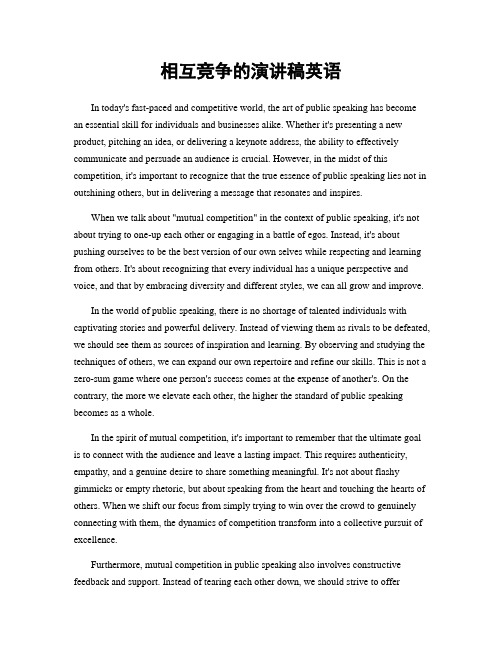
相互竞争的演讲稿英语In today's fast-paced and competitive world, the art of public speaking has become an essential skill for individuals and businesses alike. Whether it's presenting a new product, pitching an idea, or delivering a keynote address, the ability to effectively communicate and persuade an audience is crucial. However, in the midst of this competition, it's important to recognize that the true essence of public speaking lies not in outshining others, but in delivering a message that resonates and inspires.When we talk about "mutual competition" in the context of public speaking, it's not about trying to one-up each other or engaging in a battle of egos. Instead, it's about pushing ourselves to be the best version of our own selves while respecting and learning from others. It's about recognizing that every individual has a unique perspective and voice, and that by embracing diversity and different styles, we can all grow and improve.In the world of public speaking, there is no shortage of talented individuals with captivating stories and powerful delivery. Instead of viewing them as rivals to be defeated, we should see them as sources of inspiration and learning. By observing and studying the techniques of others, we can expand our own repertoire and refine our skills. This is not a zero-sum game where one person's success comes at the expense of another's. On the contrary, the more we elevate each other, the higher the standard of public speaking becomes as a whole.In the spirit of mutual competition, it's important to remember that the ultimate goal is to connect with the audience and leave a lasting impact. This requires authenticity, empathy, and a genuine desire to share something meaningful. It's not about flashy gimmicks or empty rhetoric, but about speaking from the heart and touching the hearts of others. When we shift our focus from simply trying to win over the crowd to genuinely connecting with them, the dynamics of competition transform into a collective pursuit of excellence.Furthermore, mutual competition in public speaking also involves constructive feedback and support. Instead of tearing each other down, we should strive to offerinsightful critiques and encouragement to help each other grow. By fostering a culture of collaboration and mutual respect, we create an environment where everyone can thrive and evolve as speakers.In conclusion, the concept of mutual competition in public speaking is not about seeing others as adversaries, but as fellow travelers on the journey of self-improvement and expression. By embracing this mindset, we can elevate the standards of public speaking, foster a community of support and learning, and ultimately, make a more profound impact on our audiences. So let us strive not to outshine each other, but to shine together in the light of our shared passion for the art of public speaking.。
TheArtofPublicSpeakingChapter4公众演讲的艺术第四章
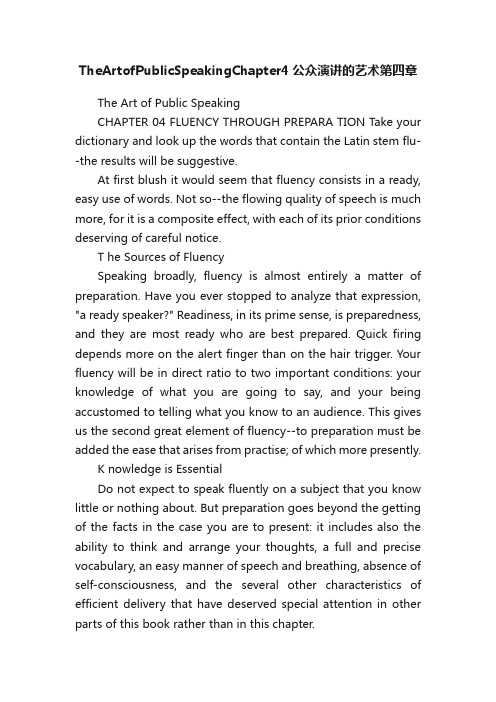
TheArtofPublicSpeakingChapter4公众演讲的艺术第四章The Art of Public SpeakingCHAPTER 04 FLUENCY THROUGH PREPARA TION Take your dictionary and look up the words that contain the Latin stem flu--the results will be suggestive.At first blush it would seem that fluency consists in a ready, easy use of words. Not so--the flowing quality of speech is much more, for it is a composite effect, with each of its prior conditions deserving of careful notice.T he Sources of FluencySpeaking broadly, fluency is almost entirely a matter of preparation. Have you ever stopped to analyze that expression, "a ready speaker?" Readiness, in its prime sense, is preparedness, and they are most ready who are best prepared. Quick firing depends more on the alert finger than on the hair trigger. Your fluency will be in direct ratio to two important conditions: your knowledge of what you are going to say, and your being accustomed to telling what you know to an audience. This gives us the second great element of fluency--to preparation must be added the ease that arises from practise; of which more presently.K nowledge is EssentialDo not expect to speak fluently on a subject that you know little or nothing about. But preparation goes beyond the getting of the facts in the case you are to present: it includes also the ability to think and arrange your thoughts, a full and precise vocabulary, an easy manner of speech and breathing, absence of self-consciousness, and the several other characteristics of efficient delivery that have deserved special attention in other parts of this book rather than in this chapter.Preparation may be either general or specific; usually it should be both. A life-time of reading, of companionship with stirring thoughts, of wrestling with the problems of life--this constitutes a general preparation of inestimable worth. Out of a well-stored mind, and--richer still--a broad experience, and--best of all--a warmly sympathetic heart, the speaker will have to draw much material that no immediate study could provide. The speaker who would speak fluently before an audience should learn to speak fluently and entertainingly with a friend. Clarify your ideas by putting them in words; the talker gains as much from his conversation as the listener. You sometimes begin to converse on a subject thinking you have very little to say, but one idea gives birth to another, and you are surprised to learn that the more you give the more you have to give. This give-and-take of friendly conversation develops mentality, and fluency in expression. Longfellow said: "A single conversation across the table with a wise man is better than ten years' study of books," and Holmes whimsically yet none the less truthfully declared that half the time he talked to find out what he thought. But that method must not be applied on the platform!P ractiseBut preparation must also be of another sort than the gathering, organizing, andshaping of materials--it must include practise, which, like mental preparation, must be both general and special.Do not feel surprised or discouraged if practise on the principles of delivery herein laid down seems to retard your fluency. For a time, this will be inevitable. While you are working for proper inflection, for instance, inflection will be demanding your first thoughts, and the flow of your speech, for the timebeing, will be secondary. This warning, however, is strictly for the closet, for your practise at home. Do not carry any thoughts of inflection with you to the platform. There you must think only of your subject. There is an absolute telepathy between the audience and the speaker. If your thought goes to your gesture, their thought will too. If your interest goes to the quality of your voice, they will be regarding that instead of what your voice is uttering.You have doubtless been adjured to "forget everything but your subject." This advice says either too much or too little. The truth is that while on the platform you must not forget a great many things that are not in your subject, but you must not think of them. Your attention must consciously go only to your message, but subconsciously you will be attending to the points of technique which have become more or less habitual by practise.A nice balance between these two kinds of attention is importantYou can no more escape this law than you can live without air: Your platform gestures, your voice, your inflection, will all be just as good as your habit of gesture, voice, and inflection makes them--no better. Even the thought of whether you are speaking fluently or not will have the effect of marring your flow of speech.Return to the opening chapter, on self-confidence, and again lay its precepts to heart. Learn by rules to speak without thinking of rules. It is not--or ought not to be--necessary for you to stop to think how to say the alphabet correctly, as a matter of fact it is slightly more difficult for you to repeat Z, Y, X than it is to say X, Y, Z--habit has established the order. Just so you must master the laws of efficiency in speaking until it is a second nature for youto speak correctly rather than otherwise. A beginner at the piano has a great deal of trouble with the mechanics of playing, but as time goes on his fingers become trained and almost instinctively wander over the keys correctly. As an inexperienced speaker you will find a great deal of difficulty at first in putting principles into practise, for you will be scared, like the young swimmer, and make some crude strokes, but if you persevere you will "win out."Thus, to sum up, the vocabulary you have enlarged by study, the ease in speaking you have developed by practise, the economy of your well-studied emphasis all will subconsciously come to your aid on the platform. Then the habits you have formed will be earning you a splendid dividend. The fluency of your speech will be at the speed of flow your practise has made habitual.But this means work. What good habit does not? No philosopher's stone that will act as a substitute for laborious practise has ever been found. If it were, it would be thrown away, because it would kill our greatest joy--the delight of acquisition. If public-speaking means to you a fuller life, you will know no greater happiness than a well-spoken speech. The time you have spent in gathering ideas and in private practise of speaking you will find amply rewarded.。
